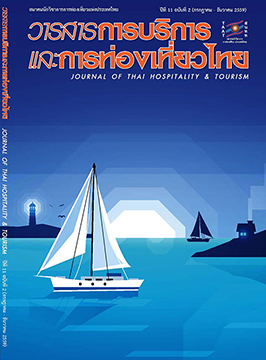The Experimental and Motivational Factors Affecting Needs in Mobile-based Food Information for Foreign Tourists Traveling in Thailand
Main Article Content
Abstract
Tourism is a source of revenue in Thailand and the most important factors in sustainable tourism is the consequent frequency of revisit. Foreign tourists in Thailand often face problems with their food because of restrictions imposed by their religions, beliefs, preferences, and health concerns. These problems tend to shorten the travel period and discourage revisit, especially for foreign tourists who have food allergies. These are problems that could possibly be reduced by providing the appropriate food information on mobile devices. Such information should be relevant to tourists’ existing consumed behaviors. Therefore, this study aims to investigate the factors of information needs in Thai food for users of mobile devices. The study employed convenience sampling using a questionnaire to collect data from 497 foreign tourists at Suvarnabhumi Airport in Thailand. The study employed descriptive statistics and regression analysis in a quantitative approach. The results revealed that technological experience influences information needs generally on mobile devices, while the experience of Thai food is not a factor in foreign tourists’ need for such information about Thai food specifically. In addition, needs in Thai food information on mobile devices are influenced by three motivation factors: health concern, learning desire, and sensory appeal. The results suggest that excitement is not a factor in foreign tourists’ needs in mobile-based information about Thai food. Finally, the result shows the high level of foreign tourists’ need for mobile-based Thai food; in particular of for information about menu ingredients and cooking methods.
Article Details
References
[2] Cohen, E. & Neal, M. (2012). A Middle Eastern Muslim Tourist Enclave in Bangkok. Tourism Geographies, 14(4), 570-598.
[3] Department of Tourism. (2015). Summary of the Situation of Tourist in August 2015. Retrieved December 12, 2015, from https://newdot2.samartmultimedia.com/home/details/11/222/24839.
[4] Eriksson, N. & Strandvik, P. (2009). Possible Determinants Affecting the Use of Mobile Tourism Services. e-Business and Telecommunications, 61-73.
[5] Flurry Analytic. (2012). App Session Growth by Country between Q1 2011 and Q1 2012. Retrieved May 5, 2013, from https://blog.flurry.com/bid/83261/China-Now-Leads-the-World-in-New-iOS-and-Android-Device-Activations.
[6] Flurry Insights. (2015). Mobile use Grows 76% Year-over-Year. Retrieved December 12, 2015, from https://flurrymobile.tumblr.com/post/115194992530/shopping-productivity-and-messaging-give-mobile
[7] Hair, J. F., Black, W. C., Babin, B. J. & Anderson, R. E. (2010). Multivariate Data Analysis (7th ed.). New Jersey: Pearson Prentice Hall.
[8] Jung, J., Chan-Olmsted, S., Park, B. & Kim, Y. (2012). Factors Affecting E-book Reader Awareness, Interest, and Intention to use. New Media & Society, 14(2), 204-224.
[9] Kim, Y. G., Eves, A. & Scarles, C. (2009). Building a Model of Local Food Consumption on Trips and Holidays: A Grounded Theory Approach. International Journal of Hospitality Management, 28(3), 423-431.
[10] Kim, Y. G., Eves, A. & Scarles, C. (2013). Empirical Verification of a Conceptual Model of Local Food Consumption at a Tourist Destination. International Journal of Hospitality Management, 33, 484-489.
[11] Mak, A. H., Lumbers, M., Eves, A. & Chang, R. C. (2012). Factors Influencing Tourist Food Consumption. International Journal of Hospitality Management, 31(3), 928-936.
[12] Promburom, Tanya & Kimpakorn, Narumon. (2015a). Factors Affecting Tourist Experience of Eco, Culture, and Wellness Tourism in the Upper Northern Provincial Cluster 1 of Thailand: Chaing Mai, Lamphun, Lampang, Mae Hongson. Journal of Thai Hospitality & Tourism, 10(1), 71-87.
[13] Promburom, Tanya & Kimpakorn, Narumon. (2015b). Perception of International Tourists on Thailand Tourism Brand under the "Amazing Thailand" campaign. Journal of Thai Hospitality & Tourism, 10(1), 15-29.
[14] Oh, S., Lehto, X. Y. & Park, J. (2009). Travelers' intent to use Mobile Technologies as a Function of Effort and Performance Expectancy. Journal of Hospitality Marketing & Management, 18(8), 765-781.
[15] Rittichainuwat., Bongkosh. Ngamsom., Qu, H. & Mongkhonvanit, Chollada. (2008). Understanding the Motivation of Travelers on Repeat Visits to Thailand. Journal of Vacation Marketing, 14(1), 5-21.
[16] Sekaran, U. & Bougie, R. (2010). Research Methods for Business: A Skill Building Approach (5th ed.). UK: John Wiley & Sons.
[17] Tussyadiah, I. P. & Fesenmaier, D. R. (2009). Mediating Tourist Experiences: Access to Places via Shared Videos. Annuals of Tourism Research, 36(1), 24-40.
[18] Wechakama, Thitisak. (2014). Creative Tourism for Prepare Thai Tourist. Journal of Thai Hospitality & Tourism, 9(1), 64-77.
[19] Wetzels, M., Odekerken-Schroder, G. & Van Oppen, C. (2009). Using PLS Path Modeling for Assessing Hierarchical Construct Models: Guidelines and Empirical Illustration. MIS Quarterly, 33(1), 177-196.

